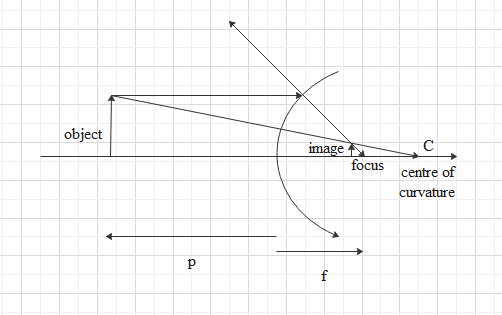
Magnification produced by a convex mirror is always:
A. Equal to1
B. Less than 1
C. More than 1
D. zero
Answer
586.2k+ views
Hint: Consider a convex mirror. Take an object in front of the mirror and describe the direction of light rays after reflection from the mirror to get the intersecting points to get the image. Magnification is measured in terms of the height of the object and the image formed. Compare the heights to get your answer.
Complete step-by-step answer:
Convex mirror is a spherical mirror where the reflective surface is outside the curved area. Convex mirror always diverges the light outward. It will not focus the light anywhere.

In the above diagram image formation is shown in a convex mirror.
Here, C is the centre of the sphere the mirror is a part of called the centre of curvature, F is the focal length of the mirror. The light rays from the object will reflect at the surface of the convex mirror and diverge outwards. The diverged ray seemed to come out of the mirror from the focal point. The ray through the centre of curvature will reflect and diverge in the opposite direction. This ray seems to come out of the centre of curvature of the mirror. Both imaginary rays will intersect at point and we will get the image.
Since, both the focal point and the centre of curvature are imaginary the image formed will be always virtual. This virtual image is always diminished. As the object will get closer to the mirror the image will get bigger and bigger but it will not get bigger than the original object.
So, the image formed in a convex mirror is always virtual and diminished. So, the magnification of a convex mirror is always less than 1.
The correct option is (B).
Note: In case of a convex mirror the magnification of the image formed is always less than 1. But if we consider a concave mirror depending on the position of the object magnification may be less than 1 or equal to 1 or greater than 1.
Complete step-by-step answer:
Convex mirror is a spherical mirror where the reflective surface is outside the curved area. Convex mirror always diverges the light outward. It will not focus the light anywhere.

In the above diagram image formation is shown in a convex mirror.
Here, C is the centre of the sphere the mirror is a part of called the centre of curvature, F is the focal length of the mirror. The light rays from the object will reflect at the surface of the convex mirror and diverge outwards. The diverged ray seemed to come out of the mirror from the focal point. The ray through the centre of curvature will reflect and diverge in the opposite direction. This ray seems to come out of the centre of curvature of the mirror. Both imaginary rays will intersect at point and we will get the image.
Since, both the focal point and the centre of curvature are imaginary the image formed will be always virtual. This virtual image is always diminished. As the object will get closer to the mirror the image will get bigger and bigger but it will not get bigger than the original object.
So, the image formed in a convex mirror is always virtual and diminished. So, the magnification of a convex mirror is always less than 1.
The correct option is (B).
Note: In case of a convex mirror the magnification of the image formed is always less than 1. But if we consider a concave mirror depending on the position of the object magnification may be less than 1 or equal to 1 or greater than 1.
Recently Updated Pages
A man running at a speed 5 ms is viewed in the side class 12 physics CBSE

The number of solutions in x in 02pi for which sqrt class 12 maths CBSE

State and explain Hardy Weinbergs Principle class 12 biology CBSE

Write any two methods of preparation of phenol Give class 12 chemistry CBSE

Which of the following statements is wrong a Amnion class 12 biology CBSE

Differentiate between action potential and resting class 12 biology CBSE

Trending doubts
What are the major means of transport Explain each class 12 social science CBSE

Which are the Top 10 Largest Countries of the World?

Draw a labelled sketch of the human eye class 12 physics CBSE

Explain sex determination in humans with line diag class 12 biology CBSE

Explain sex determination in humans with the help of class 12 biology CBSE

Differentiate between homogeneous and heterogeneous class 12 chemistry CBSE




